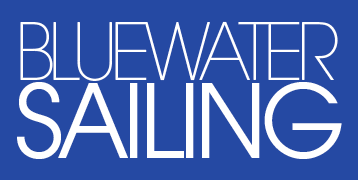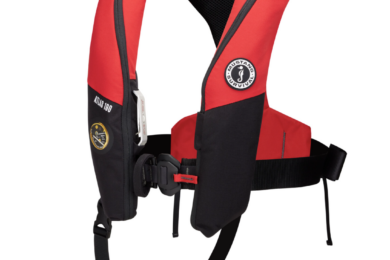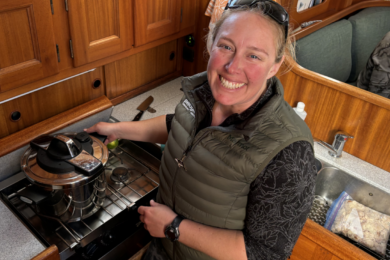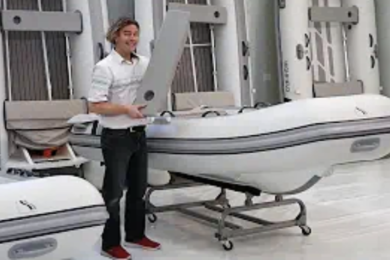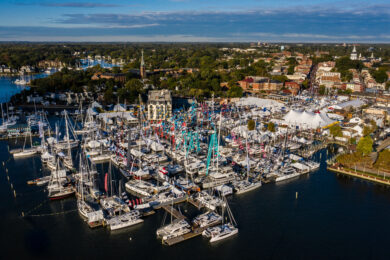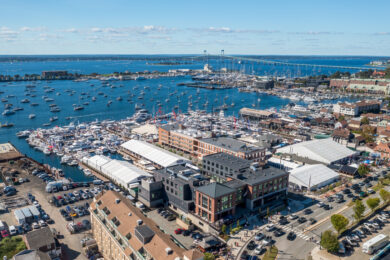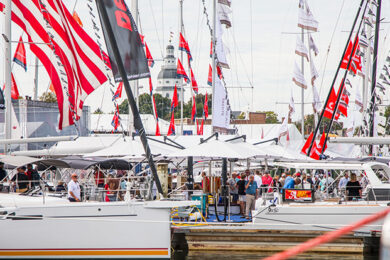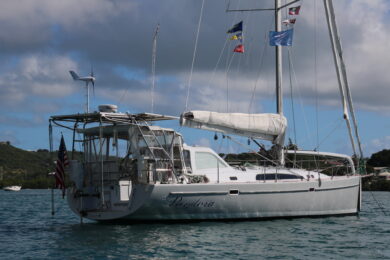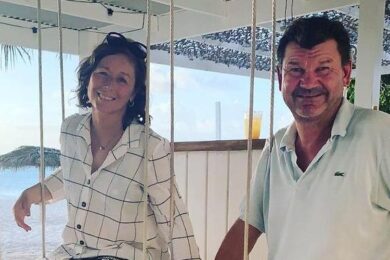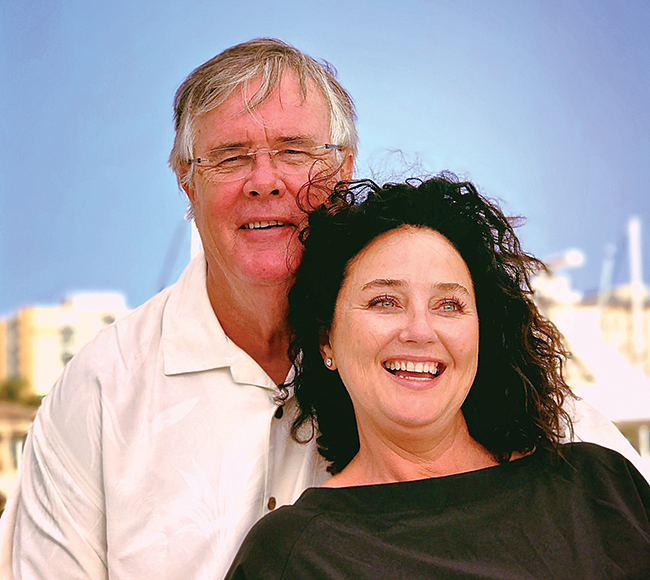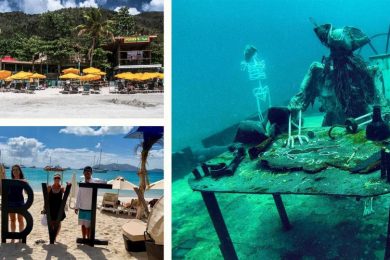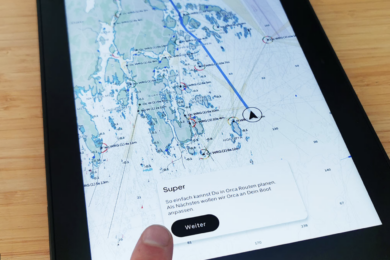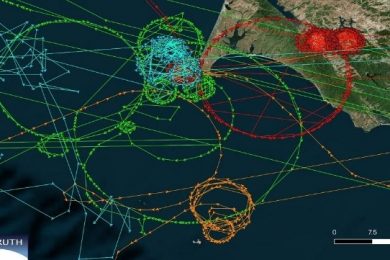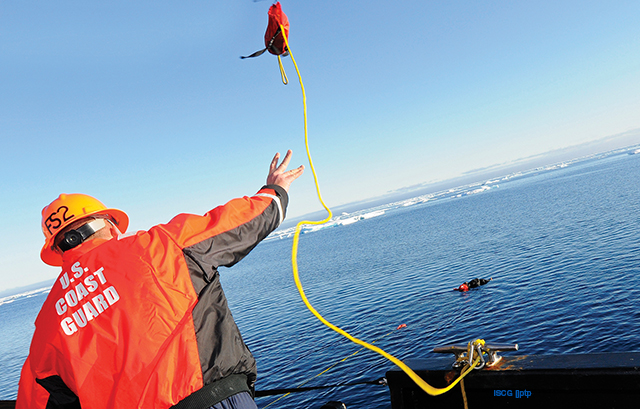A sailor’s guide to crew overboard gear (published May 2013)
While perusing the aisles of West Marine the other day, I couldn’t help but stop and stare at the plethora of crew overboard (COB) gear available to the modern sailor. From your basic Type IV cushion to an inflatable COB pole, you could fill the stern of your boat with enough safety gear to convince even the clumsiest crewmember that they are well cared for. I then envisioned that same person falling in the water while those left aboard frantically threw half a dozen things overboard instead of steering the boat, trimming the sails or starting the engine.
So what is with all this available gear and where do you begin when deciding what is right for your boat and crew? Before pondering the“what ifs” of someone falling overboard though, lets start with the number one rule in offshore sailing: stay on the boat.
STAY ON THE BOAT
In reality, there is no reason for someone to fall overboard. Unfortunately though, that is not always the case and no matter how hard we try or how careful we are when moving about the deck, accidents can and do happen. That is why when thinking about crew overboard safety we should always begin with preparation and prevention.
For starters, no amount of safety equipment on the market will keep you onboard if you are not self aware while working in the cockpit or walking on deck. Every sailor has heard the saying, “one hand for you, and one hand for the boat.” And while this is very true, you also need to make sure your movements on deck are deliberate. When moving forward, use the windward side if possible and try to avoid stepping on lines that will roll under your feet.
Lifelines got their name for a reason and are truly lifesaving devices. Regularly inspect them for corrosion and cracking and make sure the gates are secure after leaving the dock. Jacklines are your next line of defense and should be rigged on deck or chest high from the cockpit to the bow so crewmembers can move forward without having to clip and unclip as they go. Set them up before leaving the dock and practice going forward.
Every offshore sailor should have a harness and tether in their gear bag or on their boat to attach to jacklines or to pad-eyes mounted in the cockpit. Inflatable harness PFD combinations such as those made by West Marine, Mustang, Spinlock and others are more comfortable than ever and are worth the investment if you plan to sail offshore. Make sure to try them on before buying, as the fit can be slightly different from brand to brand and buy a whistle and strobe to attach to the vest. Also, learn all the features of the vest, especially how to change the CO² cartridge.
WHAT’S OUT THERE?
Crew overboard devices range from very basic to complex, but they all achieve the same goal in their design: to get something that floats to the person in the water. Even if the COB has a lifejacket on, getting them extra flotation will make them sit higher in the water and more visible to those left aboard.
The simplest throwable device beside a rope is a Type IV cushion, ring or horseshoe. These are relatively inexpensive and should be thrown as soon as a person goes overboard. That being said, they are usually hard to throw a great distance, especially into the wind.
Mustang Survival has a product called the Rescue Stick that is about 14 inches long and can be thrown 100 feet or further. When the stick hits the water it inflates into a horseshoe that offers twice the floatation of a lifejacket.
A popular crew overboard device carried by many cruisers is Forespar’s Man Overboard Pole. U.S. Sailing, ISAF and Transpac Y.C. approved for offshore racing, this 12 to 15 foot yellow pole is ballasted on one end and has a red and yellow flag on the other. Designed to help those onboard keep an eye on a person in the water, the MOB Pole can be mounted on a backstay or arch. Due to its size and weight I wouldn’t consider this a true throwable device, but it is easy to deploy into the water from the stern.
Another option for a man overboard pole is Plastimo’s Inflatable Overboard Pole. Housed in a weighted, plastic canister, the inflatable yellow pole reaches a height of five feet nine inches above the water when inflated. Also including a drogue, water-activated light, reflective tape and a red and yellow flag, this would be a good option if space around the stern were at a premium.
Several companies, including Forespar and ARC, have MOB strobe lights that are designed to be dropped overboard at night and will automatically light up when they touch water. The strobe is a bright white light that can be seen for miles at sea and will flash for over 50 hours (a USCG requirement).
If you have been anywhere near a cruising sailboat, chances are you have seen a Lifesling. Available in two sizes, the Lifesling is a bright yellow horseshoe-shaped floatation device housed in rectangular bag that has a 50-foot line attached to it. The other end of the line gets attached to the stern of the boat allowing the user to deploy the buoy and tow it to a person in the water. Once the person has made contact with the Lifesling, they slip it over their head and underneath their shoulders. With lifting tackle (also available from Lifesling), they can then be hoisted aboard. Lifeslings are USCG approved Type V PFDs that can take the place of a Type IV.
Switlik is another safety gear manufacturer with several interesting offerings for crew overboard situations. Their MOM600 is a cushion that when thrown into the water inflates into a four-person rescue platform with an inflatable pylon for increased visibility. The Techfloat is a compact throwable device with 75 feet of line attached to an inflatable horseshoe. And, the MOM 8-A and MOM 9 are systems mounted in hard plastic cases on your boat’s pushpit that are easily deployed by the pull of a pin. Once in the water the MOM 8-A inflates into a horseshoe with a six-foot inflatable pylon that has a strobe light and is tethered to the horseshoe. Also, tethered to the horseshoe is a 16-inch diameter, self-opening drogue that will help keep the person near the spot that they fell overboard. Similar to the MOM 8-A, the MOM 9 has the pylon and drogue but instead of a horseshoe, there is an inflatable, single-person pod for the COB to get into.
While this is just a partial list of the possible crew overboard gear available, it is important for each sailor to know what is available and how to use the gear that is aboard. I recommend researching what is right for your boat, crew and type of sailing so you can make the best choice. Also, when doing a safety briefing, make sure new crewmembers know how to deploy the COB system that you have.
When all is said and done, crew safety is really up to the individual sailor. Sailing offshore is a risky business but it doesn’t have to be dangerous or life-threatening if we prepare our boat and crew, clip in and move around the boat with care.
WHAT’S REQUIRED
The U.S. Coast Guard recommends that every person on a boat should wear a PFD. While they cannot force or enforce that recommendation, they do have requirements for what you should carry aboard for safety. Every vessel is required to have a Type I, II, III or V PFD onboard for each person and one Type IV throwable for the boat.
– Type I PFDs are offshore rated vests that are typically found on commercial vessels. They are bulky orange vests that are designed to roll you over in the water and keep your head afloat.
– Type II PFDs are near-shore vests that are popular because they are usually sold inexpensively at marine supply stores. Type IIs have a strap to go around the waist and a head flap, but unlike the Type I, they are not designed to roll you over in the water.
– Type III PFDs are the most common, water ski type vests that are typically the most comfortable of the first three.They too are fairly inexpensive and are great for children or people who do not want to incur the cost of an inflatable life vest.
– Type IV PFDs are throwable buoyancy devices that should be immediately thrown to someone who has fallen overboard. They come in various models and are relatively inexpensive.
– Type V PFDs are special purpose vests. This includes the inflatable harness type that many sailors wear as well as some sailing and kayaking vests that may look like a Type III. The thing to keep in mind about Type V PFDs is that they only count towards your one per crew requirement if they are being worn.
USEFUL WEBSITES
Forespar www.forespar.com
West Marin www.westmarine.com
Mustang Survival www.mustangsurvival.com
Plastimo www.plastimo.com
Spinlock www.spinlock.co.uk
Switlik www.switlik.com
